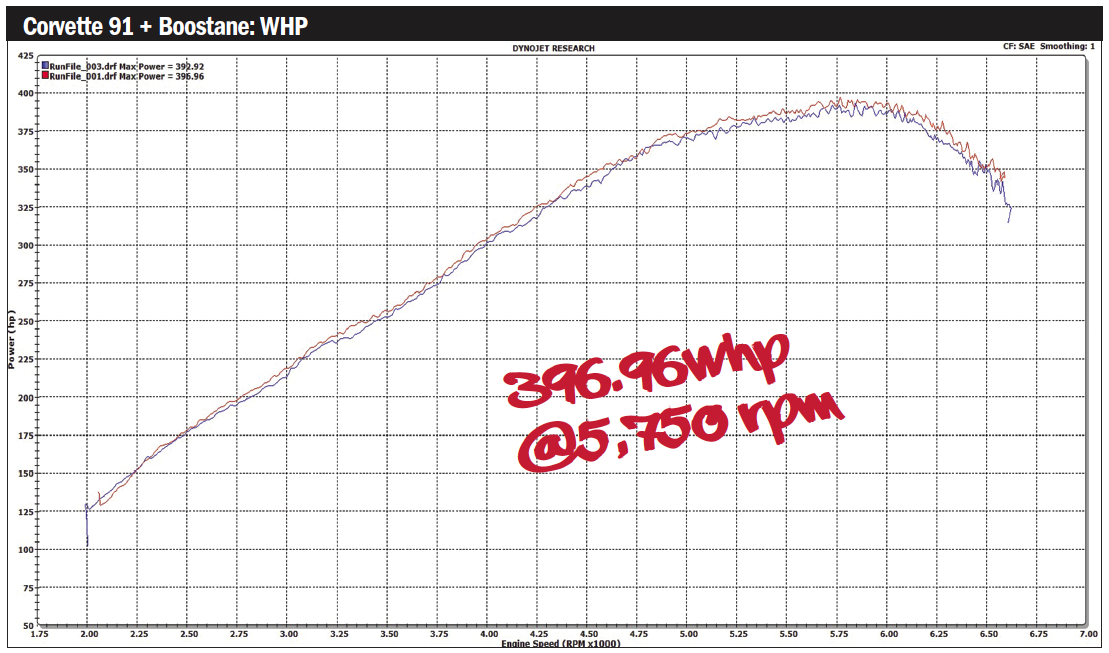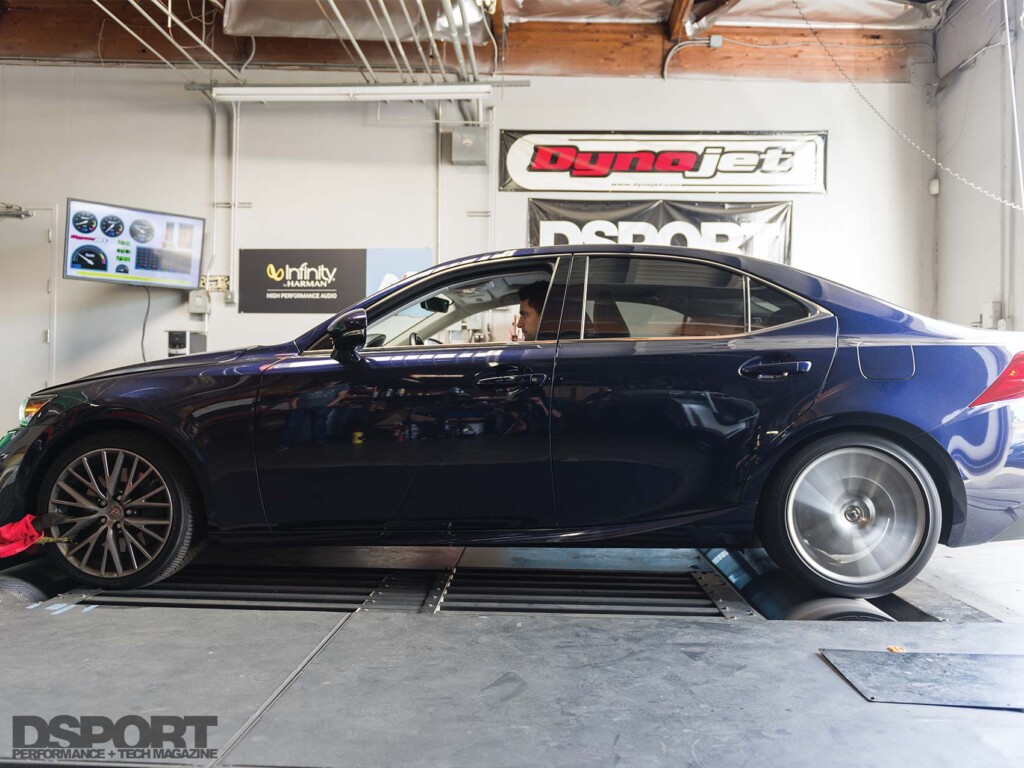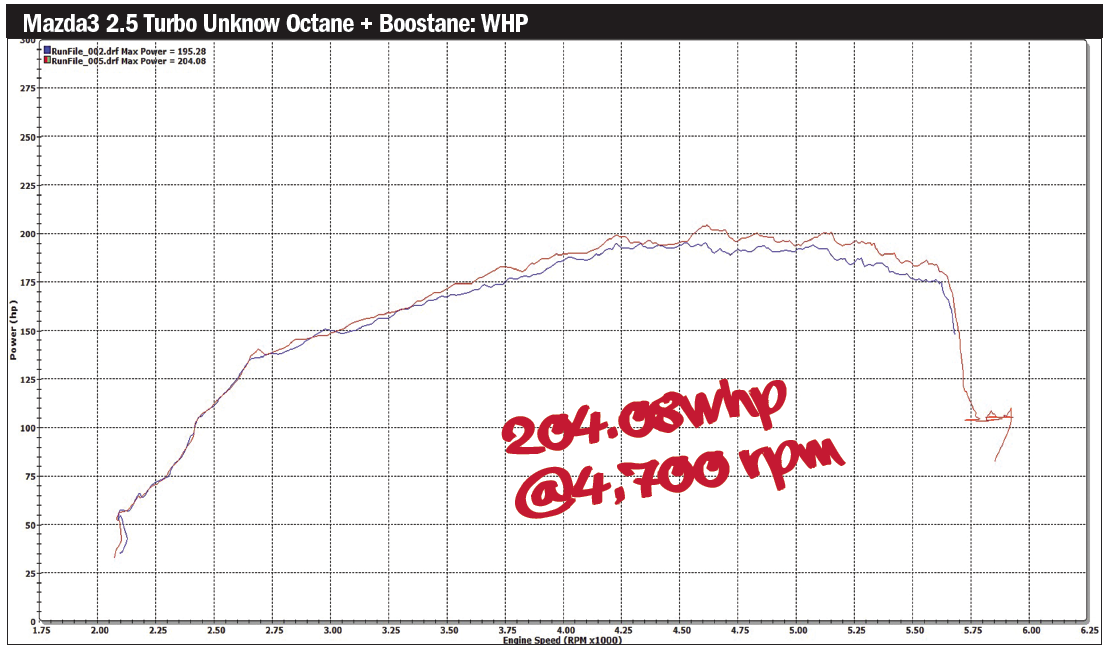While Southern California residents enjoy the weather year-round, the search for high-octane fuel is near impossible. The same struggle can be found in numerous other states. Since what you feed your engine determines its ultimate performance, many enthusiasts make the switch to either E85 gasoline-ethanol mixture, or race gas. The problem with E85 remains its availability and poor consumption, which would mean you will need to find it more often. As for race gas, the problem is the high cost. That’s when BOOSTane comes into the picture. The fuel additive is designed with a formula that increases the octane levels in whatever fuel you have in your tank. With the proper measurement, your car could be running on up to 116-octane. We wanted to see if BOOSTane would work on high-compression naturally-aspirated engines and turbocharged engines without tuning. With a bottle of BOOSTane Professional and three cars, we utilized our dyno to get some real-life data.
Text by Bassem Girgis // Photos by Joe Singleton
DSPORT Issue #226
Best Candidates
 The quality of fuel can have a huge impact on engines that benefit from one of three factors: compression ratio, engine speed potential, and boost pressure. Engines that operate at higher compression ratios (above 10:1), operate at higher engine speeds (generally above 6,500 RPM), and forced induction engines are usually the applications where improving the quality of fuel would yield significant results in performance. Modern ECUs can adapt to the change in octane in the fuel without the need for a tune for a wide enough range. So, going from 87-octane to 93-octane and back should be of no issue to a stock ECU. However, going from 87-octane to 116-octane would definitely be too far for the stock ECU to adapt to. With these factors in mind, we chose three vehicles for our test that fit the criteria.
The quality of fuel can have a huge impact on engines that benefit from one of three factors: compression ratio, engine speed potential, and boost pressure. Engines that operate at higher compression ratios (above 10:1), operate at higher engine speeds (generally above 6,500 RPM), and forced induction engines are usually the applications where improving the quality of fuel would yield significant results in performance. Modern ECUs can adapt to the change in octane in the fuel without the need for a tune for a wide enough range. So, going from 87-octane to 93-octane and back should be of no issue to a stock ECU. However, going from 87-octane to 116-octane would definitely be too far for the stock ECU to adapt to. With these factors in mind, we chose three vehicles for our test that fit the criteria.
Car 1: 2014 Corvette Stingray
By increasing the octane level on our 11.5:1 compression LT1 in the Corvette, the car delivered 397whp and 404 lb-ft of torque. This is over 4whp and 4.5 lb-ft of torque gain in a naturally-aspirated engine.
Our latest project car is a 2014 Corvette Stingray. Powered by a naturally-aspirated LT1 6.2-Liter V8 engine, the C7 has a high compression ratio of 11.5:1. The high compression engine serves as the perfect candidate for our naturally-aspirated portion of the test. On our dyno, the Corvette put down a peak 392.92whp and 399.06 lb-ft of torque. With the car running on 91-octane, we put the right amount of BOOSTane Professional in the tank for a 93-octane result. The C7 delivered 396.96whp and 403.57 lb-ft of torque; a 4.04 peak whp gain and 4.51 lb-ft of torque. The gain is throughout the entire RPM range, building a nearly identical graph only higher.
Car 2: 2017 Lexus IS200t
Our Lexus IS200t benefited from an increase in octane using BOOSTane Professional. Nearly a 10whp gain was realized without the need for a tune. A fraction over 1 lb-ft of torque was gained from the increase in octane.
Our second test was conducted on our turbocharged Lexus IS200t. Our IS200t is running on a plug-n-play signal conditioner called JB4 by Burger Motorsports. With this tune on, the Lexus delivered a peak 213.35whp and 278.44 lb-ft of torque on 91-octane fuel. Increasing the octane with BOOSTane allowed it to deliver 222.11whp and 279.65 lb-ft of torque. This is nearly a 10whp gain by just increasing the octane and no custom tune.
Car 3: 2021 Mazda3 2.5 Turbo
With unknown fuel in our Mazda3 2.5 Turbo press car and poor horsepower and torque numbers, we used half a bottle of BOOSTane Professional. The result was 10whp and 7 lb-ft of torque gain from the turbocharged 2.5-liter.
Our last test car is a prototype vehicle that desperately needed some more octane. Mazda rates this all-new platform at 250 horsepower when using 93-octane fuel. They also rate it at 227 horsepower when running on 87-octane. On our dyno, the turbocharged Mazda put down 195.28whp and 266.85 lb-ft of torque. The poor numbers led us to the conclusion that our press car had poor fuel quality in it. We increased the octane with BOOSTane and the result was 204.08whp and 273.55 lb-ft of torque. This is almost a 10whp and 7 lb-ft of torque gain.
The Benefits
With forced induction applications, heat soaking is the enemy that can cause knock/detonation. Heat soaking demands more octane to avoid knock. Increasing the octane using an additive like BOOSTane would eliminate knock. Unlike many other products, BOOSTane actually works and does increase octane. It utilizes a chemical called MMT that increases the octane rating in gasoline. This additive can offer the same octane and performance as race fuels if used properly. However, it’s important that it’s used properly. True gains can be realized with an ECU tune specifically designed for higher octane.
Who It’s for
BOOSTane can be a very cost effective way to increase performance, but it could also be troublesome. If used properly, it could replace race fuel at 50-percent of the cost. However, if you decide to re-tune your ECU to run 116-octane, you have to have another map in case you want to use the normal pump. If you decide to change the octane level to your liking, you need to be sure you add the right amount of BOOSTane depending on your current octane level in your tank. So, the question is, who is this product right for? Most beneficial for forced-induction applications, this would be a great advantage for track days, strip days, hot days when heat soaking is of concern. Using the right amount to make for high octane levels that are not beyond the factory ECU’s limits to adjust properly is another great way to use this product. Don’t expect your factory ECU to adjust between 116-octane and 87-octane. At some point, the ECU will believe something else is the problem as it continues pulling timing. If your car is a dedicated race car, tuning it to high octane and always running that level will yield the most benefits while also requiring the most attention. Unlike ethanol, there is no octane content analyzer to show you what octane number you’re running, so this will be up to you to measure. If you decide to use it without a tune, it should yield some benefits on an adaptive ECU as long as you don’t increase the octane too much.










